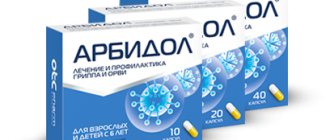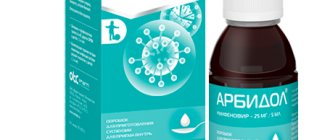Pharmacological properties of the drug Erius
Desloratadine is a selective blocker of peripheral histamine H1 receptors that does not have a sedative effect. Desloratadine is the primary active metabolite of loratadine. In preclinical studies of desloratadine and loratadine, no qualitative or quantitative differences in the toxicity of the 2 drugs at comparative doses (taking into account the concentration of desloratadine) were identified. After oral administration, Erius selectively blocks peripheral H1-histamine receptors and does not penetrate the BBB. Numerous studies have shown that in addition to antihistamine activity, Erius has antiallergic and anti-inflammatory effects. It has been established that Erius inhibits a cascade of various reactions underlying the development of allergic inflammation, namely:
- release of pro-inflammatory cytokines, including interleukins (IL): IL-4, IL-6, IL-8, IL-13;
- release of pro-inflammatory chemokines such as RANTES;
- production of superoxide anion by activated polymorphonuclear neutrophil granulocytes;
- adhesion and chemotaxis of eosinophilic granulocytes;
- expression of adhesion molecules such as P-selectin;
- IgE-dependent release of histamine, prostaglandin D2 and leukotriene C4;
- acute allergic bronchospasm in animal studies.
In clinical studies, daily intake of Erius at a dose of up to 20 mg for 14 days was not accompanied by statistically significant clinically significant changes in the cardiovascular system. Its use at a dose of 45 mg/day (9 times higher than the therapeutic dose) for 10 days did not cause an increase in the QT . Erius does not penetrate the BBB. When used at the recommended dose of 5 mg, the incidence of drowsiness did not exceed that in the placebo group. In clinical studies, Erius had no effect on psychomotor reactions when taken at a dose of up to 7.5 mg/day. Pharmacokinetics. Desloratadine is determined in blood plasma within 30 minutes after administration. The maximum concentration in the blood plasma is reached after 3 hours, the half-life is on average 27 hours. The degree of accumulation of desloratadine corresponds to its half-life (about 27 hours) and the frequency of use (1 time per day). The bioavailability of desloratadine is proportional to the dose, ranging from 5 to 20 mg. Desloratadine is moderately (83–87%) bound to plasma proteins. When used at a dose of 5–20 mg once a day for 14 days, no clinically significant accumulation of the drug was detected. When conducting cross-comparative studies with the same dose of the drug, the bioequivalence of the drug in the form of tablets and syrup was proven. The results of the studies showed that desloratadine does not inhibit CYP 3A4 or CYP 2D6 and is neither a substrate nor an inhibitor of P-glycoprotein. A single dose of desloratadine 7.5 mg with food (a high-fat, high-calorie breakfast or grapefruit juice) did not affect the distribution of desloratadine.
Instructions for use of AERIUS®
Desloratadine begins to be detected in plasma within 30 minutes after administration. Cmax of desloratadine in plasma is achieved on average after 3 hours, T1/2 is on average 27 hours. The degree of accumulation of desloratadine corresponds to its T1/2 (approximately 27 hours) and frequency of use (once daily). The bioavailability of desloratadine was dose proportional, ranging from 5 to 20 mg.
Desloratadine is moderately (83-87%) bound to plasma proteins. When using desloratadine at a dose of 5-20 mg 1 time / day for 14 days, no signs of clinically significant accumulation of the drug were found.
When conducting cross-comparative studies with the same dose of the drug, the bioequivalence of the drug in the form of tablets and syrup was revealed.
Desloratadine is effectively converted to the active metabolite 3-hydroxy-desloratadine and then glucuronidated. The enzymes responsible for the metabolism of desloratadine have not yet been established, and therefore the possibility of interaction with other drugs cannot be completely excluded. The results of in vivo and in vitro studies showed that desloratadine does not inhibit CYP3A4 or CYP2D6.
In part of the population, the conversion of desloratadine to 3-hydroxy-desloratadine is clearly slowed down due to an as yet unknown phenotypic polymorphism in metabolism. Approximately 2% of Caucasians and more than 20% of black patients have the following AUC ratio: DL/3-OH-DL>10 (normal:
- <4), and these patients are characterized as "slow inactivators". In adults classified as slow inactivators, desloratadine exposure (AUC) after multiple doses was 6 times higher than in adults with normal metabolism. The pharmacodynamic effects of these options, particularly the effect on the QTc interval, have not yet been fully established.
Studies of the effects of repeated doses of desloratadine in children have not been conducted.
When conducting pharmacokinetic studies in pediatric practice, it was found that the AUC and Cmax of desloratadine (when used in recommended doses) were comparable to the same indicators in adults taking desloratadine in the form of desloratadine syrup at a dose of 5 mg.
Patients with impaired renal function
There is no experience with repeated use of desloratadine in renal failure.
In patients with stable dysfunction, desloratadine after administration of its single dose was increased by 1.5-2.5 times, and the concentration of 3-hydroxy-desloratadine changed minimally. By hemodialysis, desloratadine was excreted only in small amounts (0.3%). In addition, plasma protein binding of desloratadine and 3-hydroxy-desloratadine was not altered in kidney disease; as a result, the concentration of unbound active substance remained unchanged.
Patients with liver dysfunction
In patients with moderate hepatic impairment, AUC may increase 3-fold. Plasma protein binding of desloratadine and 3-hydroxy-desloratadine was not altered in patients with liver disease. The incidence of adverse effects did not increase when treated for a maximum of 10 days and in patients with moderate liver damage (Child B).
A study with a single dose of desloratadine 7.5 mg found that food (high-fat, high-calorie breakfast) or grapefruit juice did not affect the distribution of desloratadine.
Use of the drug Erius
To eliminate symptoms associated with allergic rhinitis (including intermittent and persistent) and chronic idiopathic urticaria, Erius in the form of tablets or syrup is taken orally, regardless of food intake, in the following doses. Tablets Adults and adolescents (over 12 years of age) - 1 tablet (5 mg) 1 time per day. The tablet should be swallowed whole with water. It is advisable to take the drug regularly at the same time of day. The duration of treatment is determined by the severity and course of the disease. Treatment of intermittent allergic rhinitis is carried out taking into account the patient's medical history and can be stopped after the symptoms disappear and resumed when they reappear. Continuous treatment may be recommended for patients with persistent allergic rhinitis throughout the period of exposure to the allergen. Syrup Children aged 6–11 months - 2.0 ml (1 mg) 1 time per day; 1 year–5 years - 2.5 ml (1.25 mg) 1 time per day; 6–11 years - 5.0 ml (2.5 mg) 1 time per day. Adults and adolescents (over 12 years of age) are prescribed 10.0 ml of syrup once a day. The drug is taken regardless of meals.
Side effects of the drug Erius
In clinical studies, when using the drug Erius according to indications for use, including allergic rhinitis and chronic idiopathic urticaria at the recommended dose of 5 mg/day, the incidence of side effects was 3% higher than when using placebo. When using the drug Erius, the most common side effects (compared to placebo) were fatigue (1.2%), dry mouth (0.8%), headache (0.6%). Very rarely - hypersensitivity reactions (including anaphylactic reaction and rash), tachycardia, palpitations, increased activity of liver enzymes, bilirubin, hepatitis. When using syrup in children aged 6 to 23 months, diarrhea (3.7%), chills (2.3%) and insomnia (2.3%) were most often noted; in other age categories - increased fatigue (1.2%), dry mouth (0.8%), headache (0.6%).
Special instructions for the use of the drug Erius
The effectiveness and safety of using syrup in children under 6 months of age and tablets in children under 12 years of age has not been fully established. In clinical and pharmacological studies, Erius did not enhance the effects of alcohol such as impaired psychomotor function and drowsiness. Psychomotor test results did not differ significantly between patients who received Erius and placebo alone or with alcohol. During pregnancy and breastfeeding. Erius is not recommended for use during pregnancy, since the safety of the drug in pregnant women has not been established. Desloratadine passes into breast milk, so it is recommended to stop breastfeeding during treatment with the drug. effects on the ability to drive vehicles or operate complex machinery .
Instructions for use of ERIUS® (AERIUS) tab
Desloratadine is a non-sedating, long-acting antihistamine that has a selective antagonistic effect on peripheral H1-histamine receptors. After oral administration, desloratadine selectively blocks peripheral H1-histamine receptors, since the substance does not penetrate the blood-brain barrier.
In vitro studies have shown that desloratadine has antiallergic effects, including inhibition of the release of proinflammatory cytokines, including IL-4, IL-6, IL-8 and IL-13, from human mast cells/basophils, and also inhibits the expression of adhesion molecule P -selectin in endothelial cells. The clinical significance of these findings remains unknown.
In multiple-dose clinical studies, daily use of desloratadine at a dose of less than 20 mg for 14 days was not associated with statistically or clinically significant changes in the cardiovascular system. In a clinical and pharmacological study using the drug Erius at a dose of 45 mg/day (9 times higher than the therapeutic dose) for 10 days, no prolongation of the QTc interval was observed.
In interaction studies with ketoconazole and erythromycin, no clinically significant changes in plasma concentrations of desloratadine were detected.
Erius does not penetrate the blood-brain barrier. In controlled clinical studies, when using the recommended dose of 5 mg, the incidence of somnolence was not greater than that in the placebo group. In clinical studies, Erius did not affect psychomotor function when taking a dose of no more than 7.5 mg.
In a single-dose study in adults, desloratadine 5 mg did not affect standard measures of in-flight performance, including increased subjective sleepiness or impairment of the ability to perform in-flight tasks.
In clinical and pharmacological studies, desloratadine did not enhance the effects of alcohol such as impaired psychomotor function and drowsiness. Psychomotor test results were not significantly different between patients receiving desloratadine and placebo alone or in combination with alcohol.
In patients with allergic rhinitis, Erius was effective in relieving symptoms such as sneezing, nasal discharge and itching, as well as itchy and red eyes, watery eyes, and itching of the roof of the mouth.
Erius effectively controls symptoms within 24 hours. The effectiveness of Erius tablets has not been clearly demonstrated in studies in adolescents aged 12-17 years.
In addition to the established classification of rhinitis (seasonal and year-round), allergic rhinitis can be divided into intermittent and persistent based on the duration of symptoms. With intermittent rhinitis, symptoms occur less than 4 days a week or less than 4 weeks a year. For persistent rhinitis - more than 4 days a week or more than 4 weeks a year.
Erius quite effectively alleviated the condition of patients with seasonal allergic rhinitis according to the results of the total score of the quality of life questionnaire for patients with rhinoconjunctivitis. The greatest improvement was observed in the areas of practical problems and daily activities limited by the presence of symptoms.
Chronic idiopathic urticaria has been studied as a clinical model of urticaria based on the similarity of their underlying pathophysiological mechanisms regardless of etiology and the lack of problems in prospectively recruiting patients suffering from the chronic disease. Because histamine release is a causative factor in all types of urticaria, desloratadine is expected to be effective in relieving symptoms of other types of urticaria, including chronic idiopathic urticaria, as stated in clinical practice guidelines.
In two placebo-controlled, six-week trials in patients with chronic idiopathic urticaria, Erius was effective in relieving itching and reducing the size and number of rashes at the end of the first course of treatment. In each study, the effect was maintained for 24 hours after dosing. As with other studies of antihistamines in chronic idiopathic urticaria, a minority of patients who were considered refractory to antihistamine treatment were excluded. Greater than 50% relief of itching was observed in 55% of patients who received desloratadine treatment, compared with 19% of patients who received placebo. Treatment with Erius also significantly reduced the negative impact of the disease on sleep and daily activity, as measured by the four-point scale used to assess these variables.



